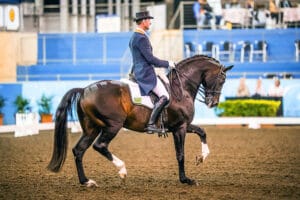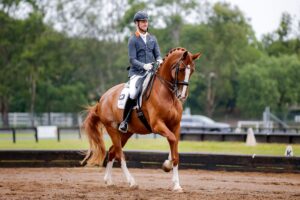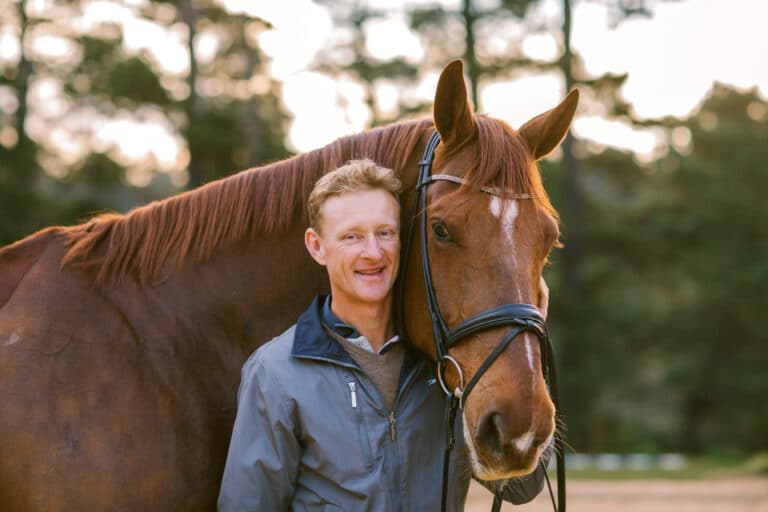Folklore abounds regarding horse colour and gender. Chestnut, black or bay, mares, geldings or stallions. But does it really matter? We asked dressage star BRETT PARBERY for his expert opinion.
Brett Parbery is a professional horse trainer and dressage rider who has twice competed for Australia, was one of the Top 10 dressage riders at the 2010 World Equestrian Games, is a four times Australian Grand Prix Champion, and winner of over 35 Australian dressage titles. And that’s aside from a previous career as a bronc rider on the US and Canadian pro rodeo circuits.
Having sat on more than a handful of horses over the years, it’s fair to say Brett knows a thing or two about the influence of horse colour and gender. So, does colour equate with certain personality traits? Brett’s short answer is a ‘no’. No specific coat colour, pattern, or number of socks is a fair way to assess a horse’s temperament. He believes the same is true for the whorls a horse sports on its head. These types of features simply don’t stand up as accurate ways to make generalisations about a horse’s personality.
Colour myth busted. Boys versus girls however, now that’s a whole other story.

Battle of the sexes
There’s an old adage which goes along the lines of tell a gelding, ask a mare, discuss it with a stallion. This is one with which Brett agrees. “Stallions tend to be a little bit sulkier, and they sulk more easily,” he says. “The Western guys have a good term for it, they call it ‘bowing-up’ or getting ‘bowie’. So, when a stallion gets into a certain frame of mind and you apply pressure of some description, like with your leg, they’ll physically push out against the actual aid. It’s a bit like you’re putting pressure on a rubber ball and the ball keeps pushing you off. It’s what stallions do in nature, they’ll bow-up against other stallions too.”
Brett adds that they’re not always like that, “but on certain days, whether it’s something that’s happened overnight, or it might be when it’s coming into spring, they might be a bit more bowie and bit more resistant to being instructed on what to do.”
To sum up, he says stallions are, generally, big sooks and need to be treated with a level of sensitivity that accommodates that. “When training a stallion, you’ve got to make sure you don’t put them in a position where they get bowie, make sure you keep telling them they’re good, keep rewarding them, and give them short stints with breaks in between. They’ve got to feel like they’re the king of the outfit and you’ve got to keep making them feel that way.”
Alpha mares
In comparison to the sensitive stud, mares can be either full of fight and valour, or chilled out and easy-going. Determining which one you’re dealing with comes down to where she would fit into a herd hierarchy. “The alpha mare is generally the one that, if she was in a herd environment, would be running the family,” Brett explains. “She’s the one who keeps her eyes open for danger, she’s the one that tells everyone else that they’re about to move and when they’re going, and she’s also the one that will have a blue. Especially if you get two alpha mares in one place, they’re going to fight for that top dog position.”
Brett reckons that for a person working with such a mare, that’s worth noting: “With an alpha mare, if you put pressure on them they will be quite violent back at you. So if we amp that pressure up a bit, say a leg aid for example, they are quicker to escalate to what you could describe as more of an emotional response.”
But if that’s not your ideal horse don’t discount the girls just yet, as not all mares are like that. “They’re not all the same. You get some mares that are very placid – they’re just like geldings. They’re the non-alpha mares in the herd that get told what to do. The alpha mare will go ‘move over here’, or ‘get out of my way’, or ‘I want to eat there’ and the mare being told will just back away. Those mares are fine, but the alpha mare is quite tricky to train,” Brett explains.
When it comes down to it, the hardest horse to train is obviously the one whose temperament doesn’t allow it to be trained. But, if we’re catagorising them by sex, the alpha mare is the hardest. “When it comes to training these girls, it’s an art form all on its own. You’ve got to get about them fairly quietly, just try and convince them that it’s a good idea to do what you want them to do, because they’ll quickly tell you when it’s not!” Brett laughs. His advice is that if you’re considering picking a young mare that you can’t yet ride, look at the attitude and temperament of the mother as the filly will often turn out to be similar.

Easy-going geldings
Geldings have a great reputation because they’re generally placid, and Brett concludes that geldings and the more subdued mares are the easiest to work with. “With those ones, you can pretty much roll through your routine, put a bit of pressure on and see how they respond. But with the entires and alphas you have to set it up, and then when something becomes ‘their idea’, you reward them. Giving the reward at the right time will make these horses want to do it again. You have to make sure your timing is really on,” he stresses.
When a stallion gets a bit bowie, or a mare becomes ‘emotional’, rather than risk a potentially bad reaction, Brett believes the best approach is to quickly give them a different exercise to do, which helps to diffuse the situation and clear their memory before you come back to the original exercise: “You just never want to go head-to-head with these ones, because it never ends up getting you the result you were after. You’re better off to skirt around them and still get the same result by being a bit clever about it.”

How to choose
The choice between stallions, geldings and different types of mares ultimately boils down to what you’re planning to do with the horse. “Dressage is the sport that requires the highest level of submission from the horse. When the dressage horse is fully trained, it has to be listening to us every step of the way because we do such intricate movements,” Brett explains. “In Grand Prix the movements come up so quickly that you can’t afford to be having those discussions with the likes of alpha mares.”
In his opinion, those mares shine in the sports of show jumping, polo and sometimes cutting. “Where the alpha mares tend to excel are sports where there’s minimal instruction to them from the rider, but the prompt, like the cow or the jump, that’s what creates their response.” He describes alpha mares as real fighters and says you’ll often hear show jumpers and polo players saying ‘nothing like a good mare’, which is true for their sport.
So the million dollar question: what’s Brett’s pick? “You can’t beat a good gelding, but look, I like them all. I love a really nice stallion, but in saying that, I’ve got all mares in the yard at the moment!”
If you want to make a solid commitment to progress your riding and training, visit brettparbery.com.au for information on The Parbery Program.
Feature Image: PPH Zeppelin, a gelding now owned by Melissa Cannon (Image by Magnus Agren Photography).



